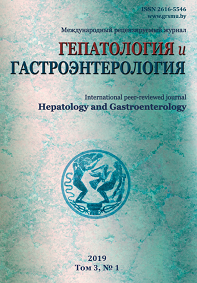MORPHOLOGICAL CHANGES IN RAT LIVER IN HYPERHOMOCYSTEINEMIA

Abstract
Background. Hyperhomocysteinemia is a pathogenetic factor of a number of diseases. The liver is a key organ in homocysteine metabolism.Objective – to study the structure of rat liver in hyperhomocysteinemia.
Materials and methods. Hyperhomocysteinemia was induced by methionine load. The liver underwent a morphological study.
Results. Hyperhomocysteinemia produces local structural changes in the microvascular liver blood flow, stimulating fibrogenesis. The majority of hepatocytes are characterized by morphological signs indicating an activation of biosynthetic processes and energy production in cells. In some hepatocytes dystrophic changes are noted, affecting mainly the nuclear apparatus and mitochondria. Specific structural changes in the mitochondria and hepatocyte endoplasmic reticulum are registered.
Conclusion. The specific changes in the liver structure were registered in methionine load-induced hyperhomocysteinemia.
References
1. Naumov AV. Gomocistein. Mediko-biologicheskie problemy [Homocysteine. Biomedical problems]. Minsk: Professionalnye izdanija; 2013. 312 p. (Russian).
2. Hankey GJ, Eikelboom JW, Ho WK, van Bockxmeer FM. Clinical usefulness of plasma homocysteine in vascular diseases. Med. J. Aust. 2004;181(6):314-318.
3. García-Tevijano ER, Berasain C, Rodríguez JA, Corrales FJ, Arias R, Martín-Duce A, Caballería J, Mato JM, Avila MA. Hyperhomocysteinemia in liver cirrhosis: mechanisms and role in vascular and hepatic fibrosis. Hypertension. 2001;38(5):1217-1221.
4. Cooper AJ. Role of the Liver in Amino Acid Metabolism. In: Zakim D, Boyer TD. Hepatology: a textbook of liver disease. 3rd ed. Vol. 1. Philadelphia: WB. Saunders; 1996. p. 563-600.
5. Finkelstein JD. Methionine metabolism in liver diseases. Nutr. Biochem. 1990;1(5):228-237. doi: 10.1093/ajcn/77.5.1094.
6. Mato JM, Martinez-Chantar ML, Lu SC. Methionine metabolism and liver disease. Annual Reviews. 2008;28:273-293. doi: 10.1146/annurev.nutr.28.061807.155438.
7. Medvedev DV, Zvjagina VI, Fomina MA. Sposob modelirovanija tjazheloj formy gipergomocisteinemii u krys [Modeling of severe hyperhomocysteinemia in rats]. Rossijskij mediko-biologicheskij vestnik im. akademika I.P. Pavlova [I.P. Pavlov Russian medical biological herald]. 2014;4:42-46. (Russian).
8. Doroshenko EM, Snezhitskiy VA, Lelevich VV. Struktura pula svobodnyh aminokislot i ih proizvodnyh plazmy krovi u pacientov s ishemicheskoj boleznju serdca i projavlenijami hronicheskoj serdechnoj nedostatochnosti [Structure of the pool of free amino acids and their derivatives in plasma of patients with ishemic heart disease and chronic cardiac insufficiency]. Zhurnal Grodnenskogo gosudarstvennogo medicinskogo universiteta [Journal of the Grodno State Medical University]. 2017;15(5):552-553. doi: 10.25298/2221-8785-2017-15-5-551-556. (Russian).
9. Liu WH, Zhao YS, Gao SY, Li SD, Cao J, Zhang KQ, Zou CG. Hepatocyte proliferation during liver regeneration is impaired in mice with methionine diet-induced hyperhomocysteinemia. Am. J. Pathol. 2010;177(5):2357-2365.
10. Tung HC, Hsu SJ, Tsai MH, Lin TY, Huo TI, Lee FY, Huang HC, Ho HL, Lin HC, Lee SD. Homocysteine deteriorates intrahepatic derangement and portal-systemic collaterals in cirrhotic rats. Clin. Sci. 2016;131(1):69-86. doi: 10.1042/CS20160470.
11. Yao L, Wang C, Zhang Xu, Peng L, Liu W, Zhang X, Liu Y, He J. Hyperhomocysteinemia activates the aryl hydrocarbon receptor/CD36 pathway to promote hepatic steatosis in mice. Hepatology. 2016;64(1):92-105. doi: 10.1002/hep.28518.
12. Medvedev DV, Zvjagina VI. Izuchenie biohimicheskih mehanizmov razvitija disfunkcii mitohondrij gepatocitov pri jeksperimentalnoj gipergomocisteinemii u krys [The study of biochemical mechanisms of mitochondrial dysfunction in rats hepatocytes during experimental hyperhomocysteinemia]. Voprosy pitanija [Problems of nutrition]. 2016;85(1):29-35. (Russian).
13. Ding WX, Li M, Biazik JM, Morgan DG, Guo F, Ni HM, Goheen M, Eskelinen EL, Yin XM. Electron microscopic analysis of a spherical mitochondrial structure. J. Biol. Chem. 2012;287(50):42373-42378. doi: 10.1074/jbc.M112.413674.
14. Kumar A, John L, Maity S, Manchanda M, Sharma A, Saini N, Chakraborty K, Sengupta S. Converging evidence of mitochondrial dysfunction in a yeast model of homocysteine metabolism imbalance. J. Biol. Chem. 2011;286(24):21779-21795. doi: 10.1074/jbc.M111.228072.
15. Yang A, Jiao Y, Yang S, Deng M, Yang X, Mao C, Sun Y, Ding N. Homocysteine activates autophagy by inhibition of CFTR expression via interaction between DNA methylation and H3K27me3 in mouse liver. Cell Death Dis. 2018;9(2):169. doi: 10.1038/s41419-017-0216-z.
16. Ai Y, Sun Z, Peng C, Liu L, Xiao X, Li J. Homocysteine induces hepatic steatosis involving ER stress response in high methionine diet-fed mice. Nutrients. 2017;9(4):pii:E346. doi: 10.3390/nu9040346.
17. Boot-Handford RP, Briggs MD. The unfolded protein response and its relevance to connective tissue diseases. Cell. Tissue Res. 2010;339(1):197-211.
18. Gotoh T, Mori M. Nitric oxide and endoplasmic reticulum stress. Arterioscler. Thromb. Vasc. Biol. 2006;26(7):1439-1446. doi: 10.1161/01.ATV.0000223900.67024.15.

















1.png)






